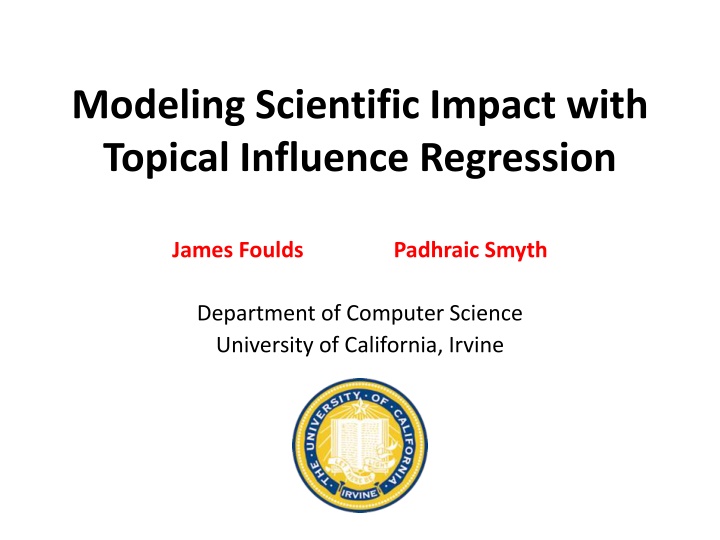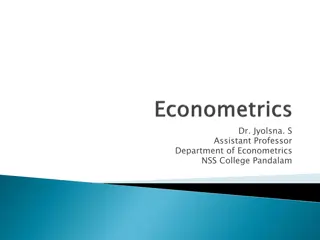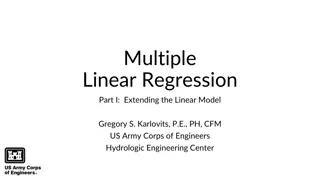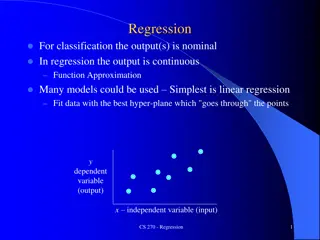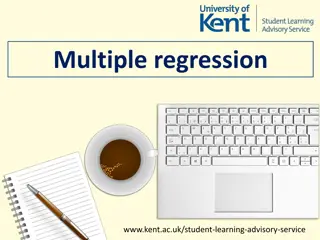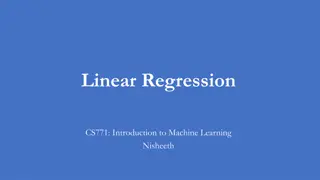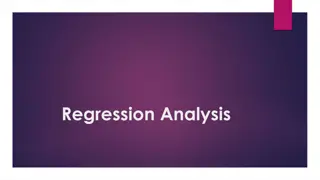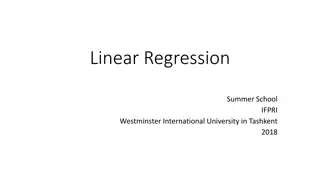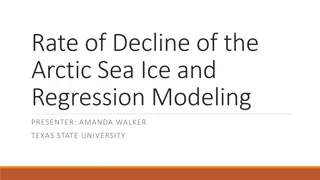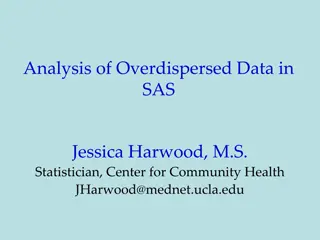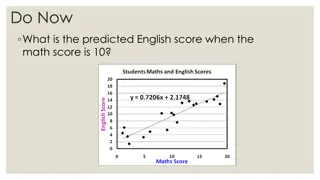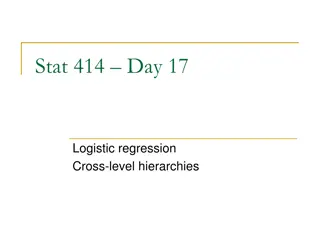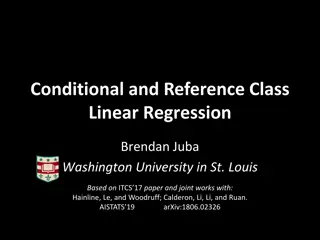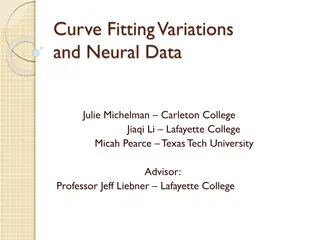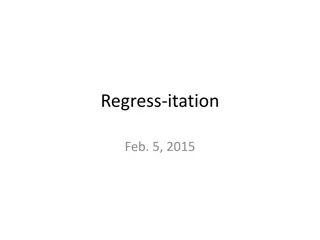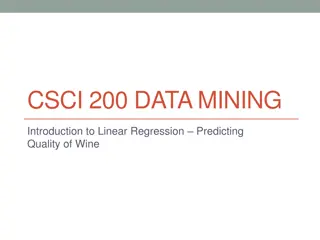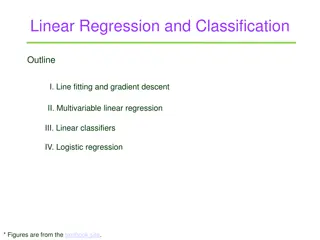Modeling Scientific Impact with Topical Influence Regression
NLP techniques enhance scientific impact assessment beyond simple citation counts by leveraging textual information. Explore the relationships between articles and the influence of topics using a flexible regression framework. Our approach uncovers node-level and edge-level influence scores in a generative probabilistic model, combining textual content and citation graph data for a comprehensive evaluation of scientific impact metrics.
Download Presentation

Please find below an Image/Link to download the presentation.
The content on the website is provided AS IS for your information and personal use only. It may not be sold, licensed, or shared on other websites without obtaining consent from the author.If you encounter any issues during the download, it is possible that the publisher has removed the file from their server.
You are allowed to download the files provided on this website for personal or commercial use, subject to the condition that they are used lawfully. All files are the property of their respective owners.
The content on the website is provided AS IS for your information and personal use only. It may not be sold, licensed, or shared on other websites without obtaining consent from the author.
E N D
Presentation Transcript
Modeling Scientific Impact with Topical Influence Regression James Foulds Padhraic Smyth Department of Computer Science University of California, Irvine
Exploring a New Scientific Area Which are the most important articles? 3
Exploring a New Scientific Area What are the influence relationships between articles? 4
Outline Background: Modeling scientific impact, topic models Metric: Topical Influence Model: Topical Influence Regression Inference Algorithm Experimental Results 5
Cant We Just Use Citation Counts? Many citations are made out of politeness, policy or piety [Ziman, 1968]. Article (A) Article (B) Built upon the ideas of (B) Mentioned (A) in passing Which article is more influential? 6
Enter: Natural Language Processing Use NLP techniques to exploit textual information in conjunction with citation information Using this extra information, we should be able to gain a deeper understanding of scientific impact than simple citation counts 7
Previous Approaches Traditional Bibliometrics Citation counts, journal impact factors, H-Index Graph-based PageRank on the citation graph PageRank on an article similarity graph (Lin, 2008) Supervised Machine Learning Classifying citation function (Teufel et al., 2006) NLP / Topic Models Dietz et al. (2007), Gerrish & Blei (2010), Nallapati et al. (2011) 8
Our Approach A metric arising from a generative probabilistic model for scientific corpora Fully unsupervised Exploits both textual content and the citation graph Recovers both node-level and edge-level influence scores A flexible, extensible regression framework 9
Latent Dirichlet Allocation Topic Models Topic models are a bag of words approach to modeling text corpora Topics are distributions over words Every document has a distribution over topics, with a Dirichlet prior Every word is assigned a latent topic, which it is assumed to be drawn from. 10
Latent Dirichlet Allocation and Polya Urns For each document Place colored balls in that document s urn, where each color is associated with a topic, and is the Dirichlet prior on the distribution over topics. For each word Draw a ball from the urn, observe its color k Draw the word token from topic k Place the ball back, along with a new ball of the same color 11
A New Metric: Topical Influence Intuition: the topical influence l(a)of article a is the extent to which it coerces the documents which cite it to have similar topics to it. Citations Influence 12
Topical Influence Regression Parameters vector for the Dirichlet prior on the distribution over topics of article a Set of articles that a cites The non-negative scalar topical influence weight for article a Normalized histogram of topic counts 13
Topical Influence Each article a has a collection of colored balls distributed according to its topic assignments Article a Article b 14
Topical Influence Each article a has a collection of colored balls distributed according to its topic assignments Article a Article b It places copies of these balls into the urn for the prior of each article that cites it Article a Article b Article c Article d Article e 15
Topical Influence Each article a has a collection of colored balls distributed according to its topic assignments Article a Article b It places copies of these balls into the urn for the prior of each document that cites it Article a Article b Article c Article d Article e 16
Topical Influence Each article a has a collection of colored balls distributed according to its topic assignments Article a Article b It places copies of these balls into the urn for the prior of each document that cites it Article a Article b Article c Article d Article e 17
Topical Influence Each article a has a collection of colored balls distributed according to its topic assignments Article a Article b It places copies of these balls into the urn for the prior of each document that cites it Article a Article b Article c Article d Article e 18
Topical Influence The topical influence weight each citing document s urn (possibly fractional) specifies how many balls article a puts into l(a) = 5 l(b) = 5 19
Topical Influence The topical influence weight each citing document s urn (possibly fractional) specifies how many balls article a puts into l(a) = 10 l(b) = 5 20
Total Topical Influence Total topical influenceT(a)is defined to be the total number of balls article a adds to the other articles urns T(a) = 20 T(b) = 10 l(a) = 10 l(b) = 5 21
Topical Influence Regression for Edge-level Influence Weights We can extend the model to handle differing influence weights on citation edges: 22
Topical Influence Regression for Edge-level Influence Weights We can extend the model to handle differing influence weights on citation edges: 23
Inference Collapsed Gibbs sampler Interleave gradient updates for the influence variables (stochastic EM) 24
Inference Collapsed Gibbs Sampler Usual LDA update, but with topical influence prior 25
Inference Collapsed Gibbs Sampler Usual LDA update, but with topical influence prior Likelihood for a Polya urn distribution. 26
Experiments Two corpora of scientific articles were used ACL (1987-2011), 3286 articles NIPS (1987-1999), 1740 articles Only citations within the corpora were considered Model validation using metadata Held-out log-likelihood Qualitative analysis 27
Model Validation Using Metadata: Number of times the citation occurs in the text 28
Self citations ACL Corpus NIPS Corpus 29
Log-Likelihood on Held-Out Documents vs LDA ACL NIPS Wins Losses Average Improvement Wins Losses Average Improvement TIR 297 33 65.7 150 20 38.2 TIRE 276 54 63.0 148 22 38.7 30
Log-Likelihood on Held-Out Documents vs LDA ACL NIPS Wins Losses Average Improvement Wins Losses Average Improvement TIR 297 33 65.7 150 20 38.2 TIRE 276 54 63.0 148 22 38.7 DMR 302 28 79.1 157 13 48.4 31
Results: Most Influential ACL Articles ACL Best Paper Award, 2005 Down to 5th place, from 1st by citation count 33
Results: Most Influential NIPS Articles Down to 13th place, from 1st by citation count Seminal papers 35
Results: Edge Influences, ACL Discriminative Training and Maximum Entropy Models for Statistical Machine Translation. F. Och and H. Ney. Toward Smaller, Faster, and Better Hierarchical Phrase-based SMT. M. Yang, J. Zheng. 1.48 2.54 A Hierarchical Phrase-Based Model for Statistical Machine Translation. D. Chiang. 0.60 0.00 An Optimal-time Binarization Algorithm for Linear Context-Free Rewriting Systems with Fan-out Two. C. Gomez-Rodriguez, G. Satta. BLEU: a Method for Automatic Evaluation of Machine Translation. K. Papineni, S. Roukos, T. Ward, W. Zhu. 36
Results: Edge Influences, ACL Discriminative Training and Maximum Entropy Models for Statistical Machine Translation. F. Och and H. Ney. Toward Smaller, Faster, and Better Hierarchical Phrase-based SMT. M. Yang, J. Zheng. 1.48 Builds upon the method 2.54 Related SMT paper A Hierarchical Phrase-Based Model for Statistical Machine Translation. D. Chiang. BLEU evaluation technique Not related 0.60 0.00 An Optimal-time Binarization Algorithm for Linear Context-Free Rewriting Systems with Fan-out Two. C. Gomez-Rodriguez, G. Satta. BLEU: a Method for Automatic Evaluation of Machine Translation. K. Papineni, S. Roukos, T. Ward, W. Zhu. 37
Results: Edge Influences, NIPS The Parti-Game Algorithm for Variable Resolution Reinforcement Learning in Multidimensional State-Spaces. A. Moore. Memory-based Reinforcement Learning: Efficient Computation with Prioritized Sweeping. A. Moore, C. Atkeson. 5.47 3.36 Feudal Reinforcement Learning. P. Dayan, G. Hinton 1.71 0.00 Multi-time Models for Temporally Abstract Planning. D. Precup, R. Sutton. A Delay-Line Based Motion Detection Chip. T. Horiuchi, J. Lazzaro, A. Moore, C. Koch. 38
Results: Edge Influences, NIPS The Parti-Game Algorithm for Variable Resolution Reinforcement Learning in Multidimensional State-Spaces. A. Moore. Memory-based Reinforcement Learning: Efficient Computation with Prioritized Sweeping. A. Moore, C. Atkeson. 5.47 3.36 Feudal Reinforcement Learning. P. Dayan, G. Hinton Less relevant Irrelevant 1.71 0.00 Multi-time Models for Temporally Abstract Planning. D. Precup, R. Sutton. A Delay-Line Based Motion Detection Chip. T. Horiuchi, J. Lazzaro, A. Moore, C. Koch. 39
Conclusions / Future Work Topical Influence is a quantitative measure of scientific impact which exploits the content of the articles as well as the citation graph Topical Influence Regression can be used to infer topical influence, per article and per citation edge Future work Authors, journals Citation context Temporal dynamics Application to social media Other dimensions of scientific importance 40
Thanks! Questions? 41
